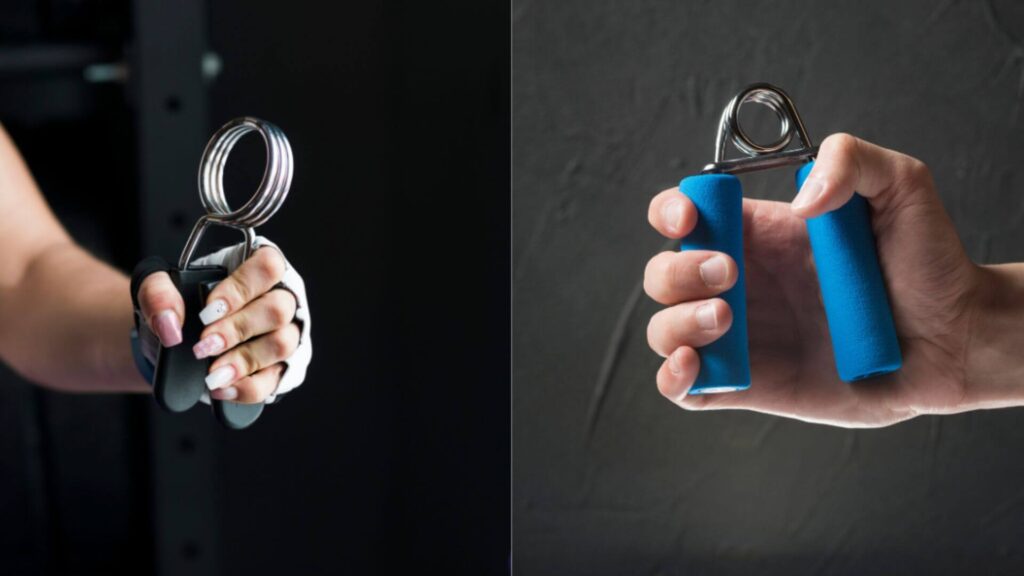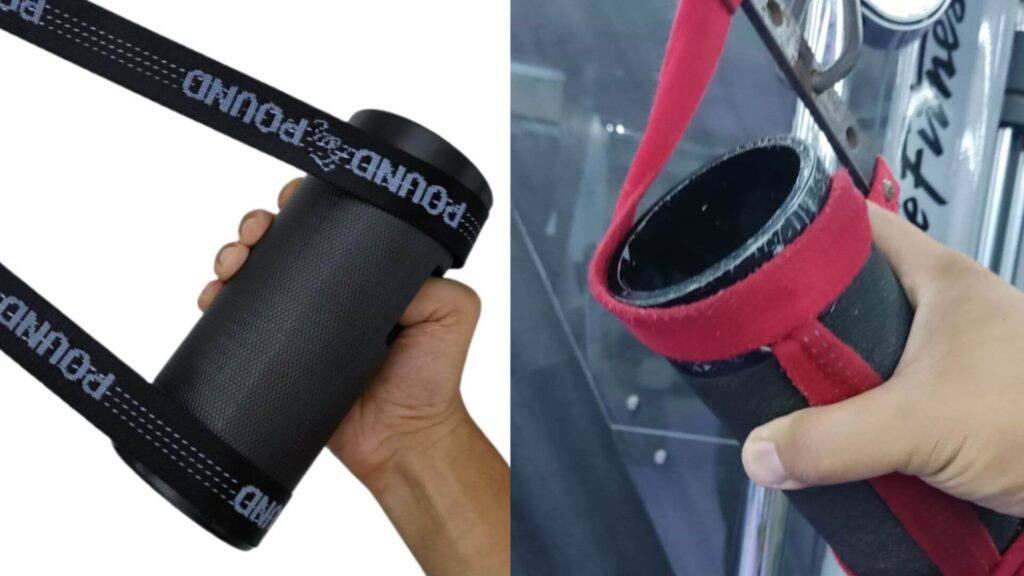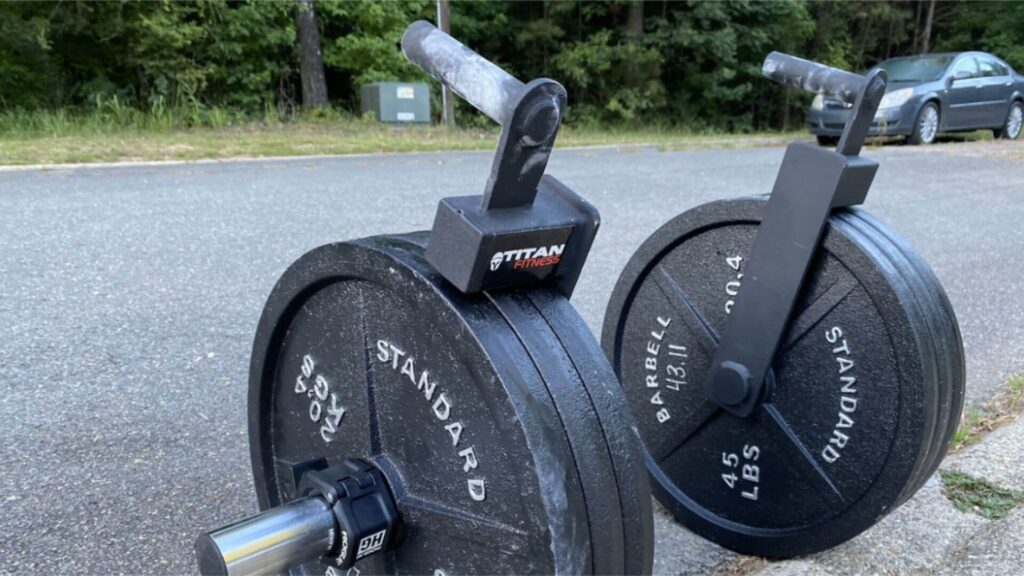Grip strength is a multifaceted aspect of physical fitness, and understanding the different types of grip variations is essential for a well-rounded healthy hand for the strength sports. In this training entry, we’ll go through the three primary types of grip: crush, pinch, and hold. Each type targets specific muscle groups and tendons and offers unique benefits. By incorporating all three into your training, you can make sure you’ll be ready for any hand related challenge at any time.
Crush Grip
The crush grip is perhaps the most familiar type of grip strength. It involves squeezing an object with your fingers and palm, exerting force inward, like when gripping a barbell, dumbbell, or hand gripper. Developing a strong crush grip is crucial for activities such as weightlifting, wrestling, and even everyday tasks like opening jars or shaking hands.

Training for Crush Grip:
Hand Grippers: Hand grippers are versatile tools designed specifically for crush grip training. They come in various resistance levels, allowing you to gradually increase your strength.
Barbell and Dumbbell Exercises: Compound lifts like deadlifts, rows, and bench presses also engage the crush grip. Using thicker barbells or adding grip challenges like fat grips can intensify your training.
Pinch Grip
The pinch grip focuses on holding an object between your fingers and thumb, typically with the fingers on one side and the thumb on the other. This type of grip is essential for activities like climbing, where you need to hold onto narrow surfaces or edges, or lifting odd-shaped objects.

Training for Pinch Grip:
Plate Pinches: Place two weight plates (smooth side out) together and grip them with your fingers on one side and your thumb on the other. Lift and hold the plates, strengthening your pinch grip.
Farmer’s Walks: Carrying objects with a pinch grip, like pinch blocks or pinch grip plates, while walking can help improve your pinch strength and overall stability.
Hold Grip (Support Grip)
The hold grip, also known as the support grip, involves maintaining a steady hold on an object for an extended period. This type of grip is vital for activities like rock climbing, where you need to maintain a secure hold for an extended duration, or carrying heavy objects over distance.
Training for Hold Grip:
Static Holds: Hang from a pull-up bar or perform dead hangs on various grips to develop your hold grip endurance. Gradually increase the duration of these holds to challenge your grip.
Farmers’ Walks: While primarily targeting the pinch grip, farmers’ walks also engage the hold
grip as you carry heavy objects over distances.
Comprehensive Grip Training
To develop a well-rounded grip, it’s essential to incorporate all three types of grip into your training regimen. A comprehensive grip training program might include:
- Crush grip exercises like hand grippers and thick-bar axle like lifts.
- Pinch grip exercises such as plate pinches and farmer’s walks with pinch blocks.
- Hold grip training with static holds with different cable attachments or dumbbells and kettlebells.
Remember to progressively increase the intensity and volume of your grip training to continue making gains. Strong and versatile grip strength not only enhances your athletic performance but also improves your daily life by making tasks that require hand strength more manageable.
While grip training is crucial for enhancing your overall strength and performance, it’s essential to approach it with caution, especially when dealing with heavy loads and challenging movements. Joints and tendons are vulnerable to overuse and injury, and it’s crucial to prioritize their health and longevity.

Tendons Take Time to Recover
Tendons, in particular, have a slower rate of recovery compared to muscles. Overloading your tendons with excessive weight or repetitive, high-intensity gripping exercises can lead to overuse injuries like tendonitis. Therefore, it’s essential to strike a balance between pushing your limits and allowing your tendons the time they need to heal and adapt.
Listen to Your Body
Pay close attention to any signs of discomfort or pain in your joints and tendons during grip training. If you experience persistent pain, it’s crucial to scale back on the intensity or volume of your grip exercises and allow your tendons to recover adequately. I personally would opt for a higher training frequency approach when it comes to grip. Dead hangs per training day greasing the groove Pavel style is my go to. Ignoring these warning signs can lead to more severe injuries that may require extended rest and rehabilitation.
Understanding and training the different types of grip—crush, pinch, and hold—provides a holistic approach to grip strength development. By incorporating exercises that target each of these grip variations, you’ll not only boost your overall hand strength but also excel in various sports and activities that demand different grip strengths. Whether you’re aiming to lift heavier weights, climb higher, or simply tackle everyday tasks like carrying groceries on each finger with ease, a comprehensive grip training routine will help you achieve your goals and enhance your physical capabilities.
Finally, mastering grip strength is a vital part of physical fitness that goes beyond the gym. A well-rounded grip is your hidden weapon, whether you’re an athlete searching for optimal performance, an explorer ascending difficult terrain, or someone simply trying to make regular activities easier. By combining crush, squeeze, and hold grip training into your routine, you’ll build a strong and versatile hand that’s ready for anything life throws at you.
However, grip training must be approached with caution and attentiveness. Remember that tendons, in particular, need time to recuperate, and pushing yourself too hard too soon might result in injuries that put you back. Always pay attention to your body’s needs and emphasize its health and longevity.
Gradually include these grip training strategies into your workout routine, increasing the intensity and volume as your strength develops. With commitment and perseverance, you will not only improve your physical ability, but you will also open doors to new opportunities and successes both inside and outside of the gym. So, tighten your hold and prepare to face life’s difficulties with confidence!


